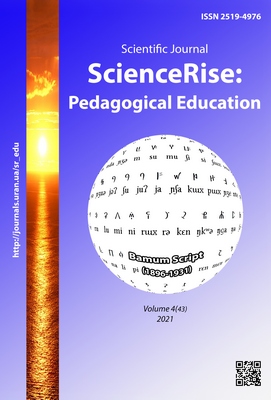Implementation of blended education at the faculty of philology
DOI:
https://doi.org/10.15587/2519-4984.2021.238439Keywords:
blended learning, distant learning, educational trajectories, independent cognitive activity, organization, interdisciplinary connections, pedagogyAbstract
This study emphasizes the need for innovation in pedagogical theory and practice. It highlights the theoretical and methodological foundations of the organization of blended learning in English teaching. The authors confirm a detailed theoretical basis, offer a model of blended learning in foreign language lessons for FLS. A blended approach to learning is one of the most relevant educational technologies today, as it allows you to take advantage of the flexibility and convenience of distance learning and the benefits of traditional forms of learning. As a result of theoretical analysis and experience of university teachers in a blended form of education, aspects that have remained outside of research are revealed. This includes the methodological potential of the organization of independent cognitive activity of FLS. The realization of this idea is impossible without the development and implementation of appropriate learning technologies.
Three main components of the blended learning model that are used in the modern educational environment are identified:
– face-to-face training (face-to-face) is a traditional format of classroom teacher-student;
– self-study learning – involves independent work of students: search for materials using a resource map, online search, etc .;
– online learning (online collaborative learning) – the work of students and teachers online, for example, through Internet conferences, Skype or wiki, etc.
References
- Maksak, I. (2013). "Blended learning" as an innovative approach in the process of primary english teacher profossional competence formation. Visnyk Chernihiv. nats. ped. un-tu im. T. H. Shevchenka. Seriya: pedahohichni nauky, 110, 247–249.
- Vorotnykova, I. P., Yakubov, S. V. (2017). Uprovadzhennia dystantsiynykh tekhnolohiy u navchalno-vykhovnyi protses zahalnoosvitnikh navchalnykh zakladiv. Kyiv: Kyiv, un-t im. B. Hrinchenka, 140.
- Vorotnykova, I. P. (2014). Information and educational environment for various forms of education in modern school. Informatyka ta informatsiyni tekhnolohiyi v navchalnykh zakladakh, 6 (54), 3–10.
- Kukharenko, V. M., Berezenska, S. M., Buhaichuk, K. L., Oliynyk, N. Yu., Oliynyk, T. O., Rybalko, O. V. et. al.; Kukharenko, V. M. (Ed.) (2016). Teoriya ta praktyka zmishanoho navchannia. Kharkiv: «Miskdruk», NTU «KhPI», 284.
- Oliynyk, V. V. (2013). Vidkryta pisliadyplomna pedahohichna osvita ta dystantsiyne navchannia u zapytanni ta vidpovidachakh. Kyiv: «A.S.K», 312.
- Tomlinson, B., Whittaker, C. (Eds.) (2013). Blended Learning in English Language Teaching: Course Design and Implementation. London. Available at: https://www.teachingenglish.org.uk/sites/teacheng/files/pub_D057_Blended %20learning_FINAL_WEB %20ONLY_v2.pdf
- Bañados, E. (2013). A Blended-learning Pedagogical Model for Teaching and Learning EFL Successfully Through an Online Interactive Multimedia Environment. CALICO Journal, 23 (3), 533–550. doi: https://doi.org/10.1558/cj.v23i3.533-550
- Stracke, E. (2007). A road to understanding: A qualitative study into why learners drop out of a blended language learning (BLL) environment. ReCALL, 19 (1), 57–78. doi: https://doi.org/10.1017/s0958344007000511
- Hockly, N. (2018). Blended Learning. ELT Journal, 72 (1), 97–101. doi: https://doi.org/10.1093/elt/ccx058
- Bijeikienė, V., Rašinskienė, S., Zutkienė, L. (2011). Teachers’ Attitudes Towards the Use of Blended Learning in General English Classroom. Studies About Languages, 18, 122–127. doi: https://doi.org/10.5755/j01.sal.0.18.420
Downloads
Published
How to Cite
Issue
Section
License
Copyright (c) 2021 Valerii Budak, Svitlana Zaskaleta, Oksana Oleksyuk

This work is licensed under a Creative Commons Attribution 4.0 International License.
Our journal abides by the Creative Commons CC BY copyright rights and permissions for open access journals.
Authors, who are published in this journal, agree to the following conditions:
1. The authors reserve the right to authorship of the work and pass the first publication right of this work to the journal under the terms of a Creative Commons CC BY, which allows others to freely distribute the published research with the obligatory reference to the authors of the original work and the first publication of the work in this journal.
2. The authors have the right to conclude separate supplement agreements that relate to non-exclusive work distribution in the form in which it has been published by the journal (for example, to upload the work to the online storage of the journal or publish it as part of a monograph), provided that the reference to the first publication of the work in this journal is included.








